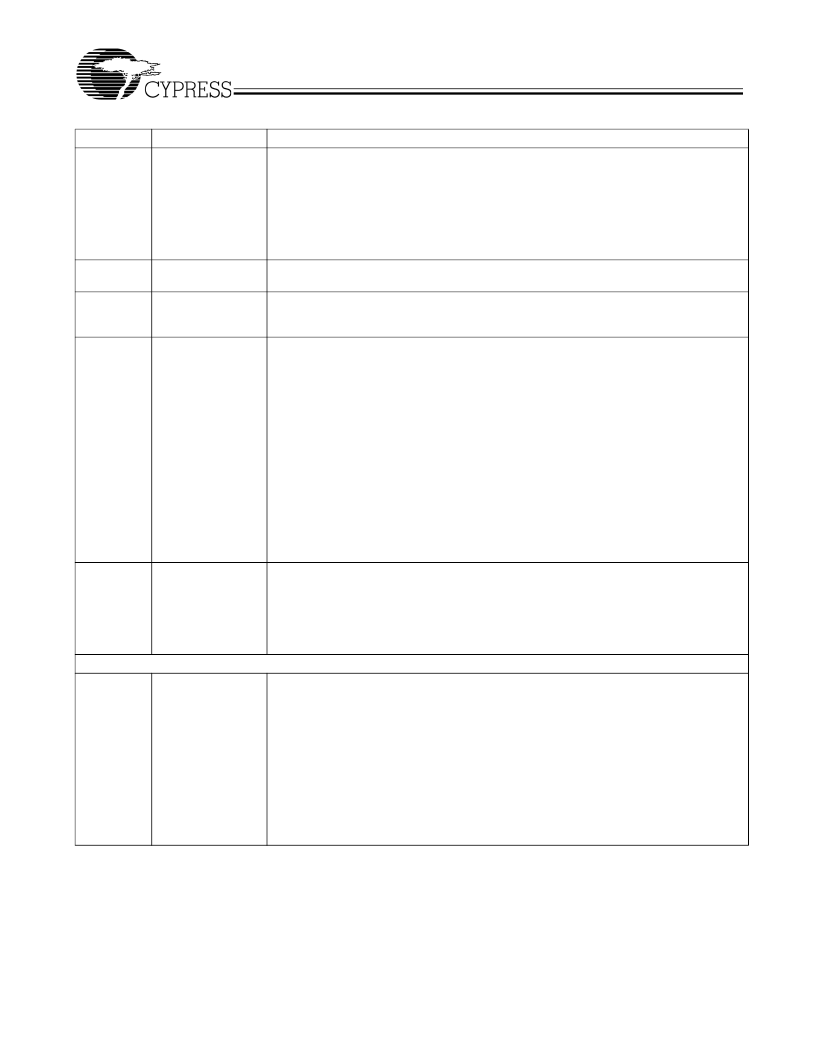- 您現(xiàn)在的位置:買賣IC網(wǎng) > PDF目錄378517 > CYV15G0201DXB-BBC (CYPRESS SEMICONDUCTOR CORP) Dual-channel HOTLink II Transceiver PDF資料下載
參數(shù)資料
| 型號(hào): | CYV15G0201DXB-BBC |
| 廠商: | CYPRESS SEMICONDUCTOR CORP |
| 元件分類: | 通信及網(wǎng)絡(luò) |
| 英文描述: | Dual-channel HOTLink II Transceiver |
| 中文描述: | SPECIALTY TELECOM CIRCUIT, PBGA196 |
| 封裝: | 15 X 15 MM, 1.50 MM HEIGHT, FBGA-196 |
| 文件頁數(shù): | 9/46頁 |
| 文件大小: | 577K |
| 代理商: | CYV15G0201DXB-BBC |
第1頁第2頁第3頁第4頁第5頁第6頁第7頁第8頁當(dāng)前第9頁第10頁第11頁第12頁第13頁第14頁第15頁第16頁第17頁第18頁第19頁第20頁第21頁第22頁第23頁第24頁第25頁第26頁第27頁第28頁第29頁第30頁第31頁第32頁第33頁第34頁第35頁第36頁第37頁第38頁第39頁第40頁第41頁第42頁第43頁第44頁第45頁第46頁

CYP15G0201DXB
CYV15G0201DXB
Document #: 38-02058 Rev. *G
Page 9 of 46
DECMODE
3-Level Select
[5]
Static Control Input
Decoder Mode Select
.
This input selects the behavior of the Decoder block.
When LOW, the Decoder is bypassed and raw 10-bit characters are passed to the Output
Register. When the Decoder is bypassed, RXCKSEL must be MID.
When MID, the Decoder is enabled and the Cypress Decoder table for Special Code
characters is used. When HIGH, the Decoder is enabled and the alternate Decoder table
for Special Code characters is used. See
Table 25
for a list of the Special Codes supported
in both encoded modes.
Receive Operating Mode
.
These inputs are interpreted to select one of nine operating
modes of the receive path. See
Table 13
for details.
Reframe Enable for All Channels
. Active HIGH. When HIGH, the framers in both channels
are enabled to frame per the presently enabled framing mode and selected framing
character.
Reframe Mode Select
. Used to control the type of character framing used to adjust the
character boundaries (based on detection of one or more framing characters in the received
serial bit stream). This signal operates in conjunction with the presently enabled channel
bonding mode, and the type of framing character selected.
When LOW, the low-latency framer is selected. This will frame on each occurrence of the
selected framing character(s) in the received data stream. This mode of framing stretches
the recovered clock for one or multiple cycles to align that clock with the recovered data.
When MID, the Cypress-mode multi-byte parallel framer is selected. This requires a pair of
the selected framing character(s), on identical 10-bit boundaries, within a span of 50 bits,
before the character boundaries are adjusted. The recovered character clock remains in the
same phasing regardless of character offset.
When HIGH, the alternate mode multi-byte parallel framer is selected. This requires
detection of the selected framing character(s) of the allowed disparities in the received serial
bit stream, on identical 10-bit boundaries, on four directly adjacent characters. The
recovered character clock remains in the same phasing regardless of character offset.
Framing Character Select
. Used to control the character or portion of a character used for
character framing of the received data streams.
When MID, the framer looks for both positive and negative disparity versions of the 8-bit
Comma character. When HIGH, the framer looks for both positive and negative disparity
versions of the K28.5 character. Configuring FRAMCHAR to LOW is reserved for
component test.
RXMODE[1:
0]
RFEN
3-Level Select
[5]
Static Control Inputs
LVTTL input,
asynchronous,
internal pull-down
3-Level Select
[5]
Static Control Input
RFMODE
FRAMCHAR 3-Level Select
[5]
Static Control Input
Device Control Signals
PARCTL
3-Level Select
[5]
Static Control Input
Parity Check/Generate Control
. Used to control the different parity check and generate
functions.
When LOW, parity checking is disabled, and the RXOPx outputs are all disabled (High-Z).
When
MID,
and
the
Encoder/Decoder
DECMODE
≠
LOW), TXDx[7:0] inputs are checked (along with TXOPx) for valid ODD parity,
and ODD parity is generated for the RXDx[7:0] outputs and presented on RXOPx. When
the Encoder and Decoder are disabled (TXMODE[1]
=
LOW, DECMODE
=
LOW), the
TXDx[7:0] and TXCTx[1:0] inputs are checked (along with TXOPx) for valid ODD parity, and
ODD parity is generated for the RXDx[7:0] and RXSTx[1:0] outputs and presented on
RXOPx. When HIGH, parity checking and generation are enabled. The TXDx[7:0] and
TXCTx[1:0] inputs are checked (along with TXOPx) for valid ODD parity, and ODD parity is
generated for the RXDx[7:0] and RXSTx[2:0] outputs and presented on RXOPx.
are
enabled
(TXMODE[1]
≠
LOW,
Pin Descriptions
CYP(V)15G0201DXB Dual HOTLink II Transceiver (continued)
Pin Name
I/O Characteristics
Signal Description
相關(guān)PDF資料 |
PDF描述 |
|---|---|
| CYV15G0404RB-BGC | Independent Clock Quad HOTLink Reclocking Deserializer |
| CYW15G0101DXB | Single-channel HOTLink II Transceiver(單通道熱連接II收發(fā)器) |
| CYW2315 | Serial Input PLL with 1.2-GHz Prescaler(帶1.2-GHz 預(yù)標(biāo)定器的串聯(lián)輸入PLL) |
| CYW2320 | Serial Input PLL with 2.0-GHz Prescaler(帶2.0-GHz 預(yù)標(biāo)定器的串聯(lián)輸入PLL) |
| CYW2325 | Serial Input PLL with 2.5-GHz Prescaler(帶2.5-GHz 預(yù)標(biāo)定器的串聯(lián)輸入PLL) |
相關(guān)代理商/技術(shù)參數(shù) |
參數(shù)描述 |
|---|---|
| CYV15G0201DXB-BBI | 制造商:Cypress Semiconductor 功能描述: |
| CYV15G0201DXB-BBXC | 功能描述:電信線路管理 IC Dual Ch Video COM RoHS:否 制造商:STMicroelectronics 產(chǎn)品:PHY 接口類型:UART 電源電壓-最大:18 V 電源電壓-最小:8 V 電源電流:30 mA 最大工作溫度:+ 85 C 最小工作溫度:- 40 C 安裝風(fēng)格:SMD/SMT 封裝 / 箱體:VFQFPN-48 封裝:Tray |
| CYV15G0201DXB-BBXI | 功能描述:電信線路管理 IC Dual Ch Video IND RoHS:否 制造商:STMicroelectronics 產(chǎn)品:PHY 接口類型:UART 電源電壓-最大:18 V 電源電壓-最小:8 V 電源電流:30 mA 最大工作溫度:+ 85 C 最小工作溫度:- 40 C 安裝風(fēng)格:SMD/SMT 封裝 / 箱體:VFQFPN-48 封裝:Tray |
| CYV15G0203TB | 制造商:CYPRESS 制造商全稱:Cypress Semiconductor 功能描述:Independent Clock Dual HOTLink II⑩ Serializer |
| CYV15G0203TB_07 | 制造商:CYPRESS 制造商全稱:Cypress Semiconductor 功能描述:Independent Clock Dual HOTLink II⑩ Serializer |
發(fā)布緊急采購(gòu),3分鐘左右您將得到回復(fù)。